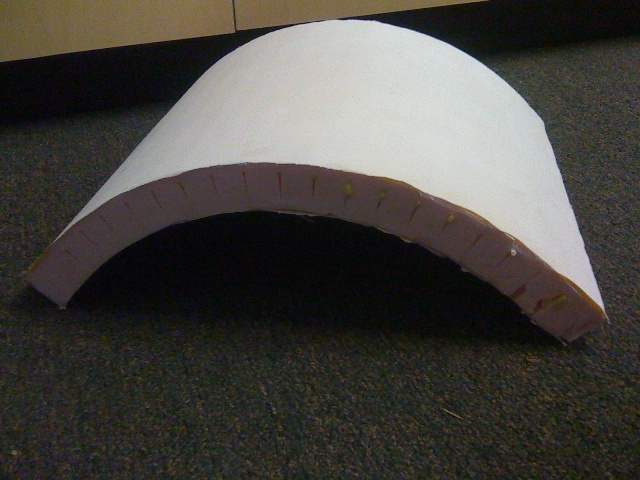So I've decided to keep my 18.5' Class C until I find some other rig, for now this is fine to get me back on the road (though I'd debated getting a van to rehab blablabla). When I bought it it was technically "totaled". The family that owned it first when new, the wife ran it through a McDonald's drive-through and crumpled the top part a bit. Of course I think this was just insurance fraud, but that's just my opinion.
Anyaway I essentially bought a fairly new rig (on the insides) for pretty cheap but have been failing at attempts to patch the front right edge and the useless non-fan vent over the top bed where water puddles. I've used eternabond, that pudding-thick rubber roof coating, I even gorilla-glued a white tarp up there with eternabonded edges, which worked spectacularly well for a year until one day at 70 mph it dramatically all ripped off and flew away to Oz on the freeway. Once a depression starts, the puddling only gets worse. I was going to just take out the top vent and plywood over the top and re-seal the edges with fiberglass and resin and fiberglass the plywood, which I can screw into the framework. But all that fiberglass and resin is very expensive. Then I came across what they're galling "Ghetto Fiberglass" in a few articles.
Basically they use rigid foam board and cover it with fabric, like canvas or bed sheets, that is dipped in 50:50 Titebond II glue/water and spread out (to remove bubbles), then later it's "heat sealed" with a heat gun or iron, then later painted, and it's supposed to last years and years.
I'm considering trying this. I was thinking of using the Harbor Freight hot knife so I could cut grooves or kerfs to make curves, or generally just trim the foam board, which actually is quite the chore to cut with a saw. So I don't know if this will actually work or not, just trying to salvage my RV for use.
http://www.instructables.com/id/Poor-Mans-Fiberglass-make-nearly-anything-weatherp/
Here's a man (a "foamie") making a rigid foam kayak and covering it with Titebond II/paint. There are also articles of folks making teardrop campers out of this stuff.
I would think you could paint it and THEN resin it, and it would be extremely durable.

 [img=370x370]https://shop.harborfreight.com/medi...d08d6e5fb8d27136e95/i/m/image_22935.jpg[/img]
[img=370x370]https://shop.harborfreight.com/medi...d08d6e5fb8d27136e95/i/m/image_22935.jpg[/img]



Anyaway I essentially bought a fairly new rig (on the insides) for pretty cheap but have been failing at attempts to patch the front right edge and the useless non-fan vent over the top bed where water puddles. I've used eternabond, that pudding-thick rubber roof coating, I even gorilla-glued a white tarp up there with eternabonded edges, which worked spectacularly well for a year until one day at 70 mph it dramatically all ripped off and flew away to Oz on the freeway. Once a depression starts, the puddling only gets worse. I was going to just take out the top vent and plywood over the top and re-seal the edges with fiberglass and resin and fiberglass the plywood, which I can screw into the framework. But all that fiberglass and resin is very expensive. Then I came across what they're galling "Ghetto Fiberglass" in a few articles.
Basically they use rigid foam board and cover it with fabric, like canvas or bed sheets, that is dipped in 50:50 Titebond II glue/water and spread out (to remove bubbles), then later it's "heat sealed" with a heat gun or iron, then later painted, and it's supposed to last years and years.
I'm considering trying this. I was thinking of using the Harbor Freight hot knife so I could cut grooves or kerfs to make curves, or generally just trim the foam board, which actually is quite the chore to cut with a saw. So I don't know if this will actually work or not, just trying to salvage my RV for use.
http://www.instructables.com/id/Poor-Mans-Fiberglass-make-nearly-anything-weatherp/
Here's a man (a "foamie") making a rigid foam kayak and covering it with Titebond II/paint. There are also articles of folks making teardrop campers out of this stuff.
I would think you could paint it and THEN resin it, and it would be extremely durable.











